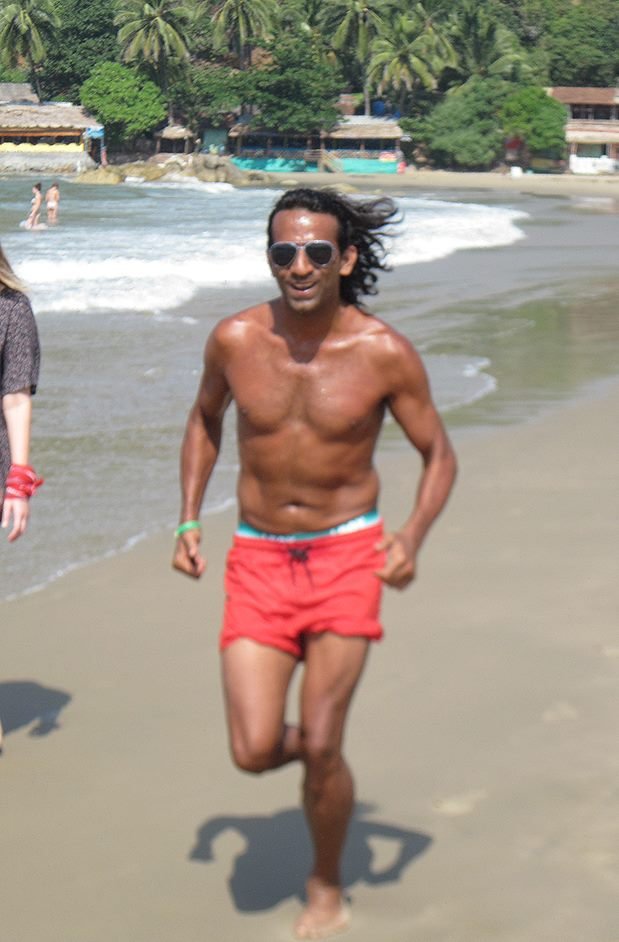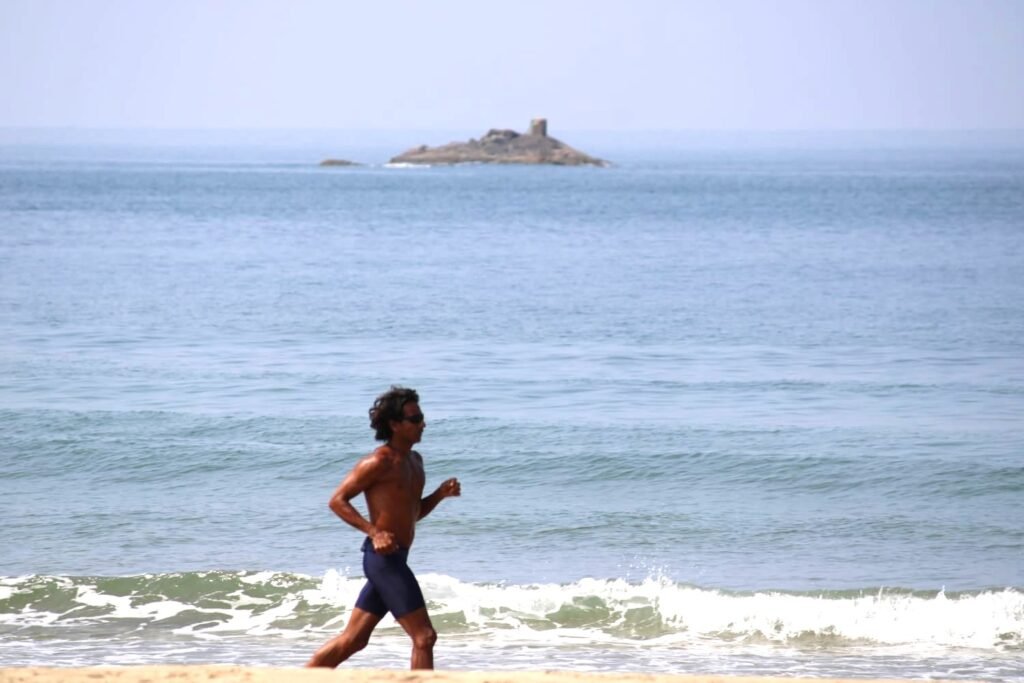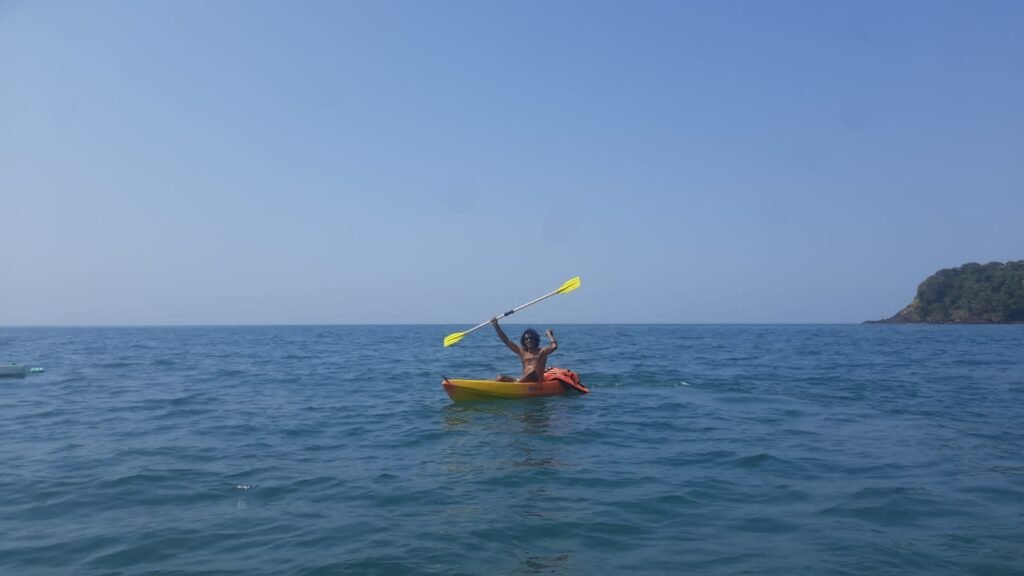
This Running on the Beach post is Sponsored by GoaHolidayVillaRental.in – It is one of the leading online platforms to book your holiday villa for rent in Goa for the best prices. You can visit their website, https://www.goaholidayvillarental.in/ to experience a luxurious stay on corporate outing, family holidays and events, bachelor parties, and more…
Running On the Beach – Part 2
Table Of Contents:
- How to overcome the risks and challenges of running on the beach?
- Who should avoid running on the beach, but should you? [This part is debatable]
- Your body will guide you
- Running on the beach is not for everyone
- Other thrilling activities at the beach
- Conclusion
- Click here to go back to: Running on the Beach – Part 1
How to overcome the risks and challenges of running on the beach?
While the beach beckons you with scenic charm and fitness advantages, it is essential to acknowledge the potential risks involved in running on the sand. The very features contributing to its benefits can also present potential risks and challenges. Here’s how to overcome the challenges and ensure a safe and rewarding beach run experience.

Awareness of weather condition
- Wind resistance and support: Strong winds from opposite directions will slow you down, and you must apply more energy to push forward. Similarly, the wind on the back will aid you in running faster and with less effort. You must change your running gait or form accordingly to prevent injury to your ankle, knees, and back. If you are reaching a point and getting back, then the wind will aid you half the way and resist you on the other half. Also, you will get the elevated side on both your legs. You must mentally plan and conserve your energy to complete your goal.
- Bad weather: Avoid running during heavy rains. It may be thrilling for short-distance sprinters but annoying for long-distance runners. Also, there is a potential safety risk of lightning strikes. If you are on limited beach running days, it is better to avoid monsoons. It is better to stick with the treadmill running on rainy days.
Watch where you are going while running on the beach
You could get injured with one wrong step while running on the beach. Even clean beaches have holes and craters. I have seen small kids make holes in the sand and leave without filling them up again. You could tear your ankle ligaments if you step into such holes at a good speed. Limping and pain will dampen the fun for the rest of your holidays.
Then there are natural hazards like debris, stones, shells, and twigs on the sand. What annoys me more are man-made hazards like bottles (sometimes broken), beer cans, ropes, nets, and plastic bottles. I’ve gone on beach cleaning drives for a couple of months and am convinced that humans are the worst enemies of nature.

Your watchful eyes must detect these things before they come under your step, especially when you are doing a good speed. It does not mean that you have to run with your head tilted down all the time because that could cause multiple stress injuries to your neck and shoulders.
I scan my path for about 15 meters ahead of me at all times. I roll my eyes down to look closer instead of dipping my neck and straining my neck. This helps me avoid making last-second changes and injuring my ankle or knee while running on the beach.
The Mind-Body connection
Despite all my precautions, hard and sharp objects can still come under my feet. It is not easy to navigate when there are many pebbles, shells, or stones close to each other. I try to zig-zag or move sideways, but I cannot possibly avoid them all. Here is where I use the alertness of my mind.
I have experienced the pain of stepping on hard objects many times. The pain can be excruciating if you strike one with your heel. With many years of practice and having learned it the hard way, my mind is tuned to feel the things the moment they touch the skin of my feet. The moment I feel the threat of a stone or hard object under my feet, my mind signals me to stop my leg from going further down. It just retracts involuntarily without me even thinking about it. All this happens in a split second, and you may not even notice the change in my gait.
Beach running is the best way to improve your health and fitness, but you must understand that it also comes with its set of challenges. Keep your eyes open and watch your step.
Dogs want to have fun, too
If you are running on Goan beaches, you must also keep your eyes open for packs of dogs. Dogs don’t bother you when alone but tend to act funny in groups. Some of them may want to run with you, while a few rouge fellows are determined to bite your leg when they catch up. Most of the time, they stop chasing you if you stop running. You could continue walking for some distance before resuming your run. They are territorial and do not chase you for long distances.
I take a small bamboo stick (about 2 feet) while running. It serves as a deterrent for the packs that want to join me for a run. Keep your eyes open and walk a few steps if you have to. It will mess up the timing by a few seconds when running against the clock, but you will be safe and can try it on some other day.
Respect nature and leave no trace
Beaches are eco-sensitive areas, and it is our duty to keep them clean. Don’t leave behind any trash you generate, as it will find its way to the sea and contribute to the destruction of marine life. Don’t disturb wildlife or nesting areas on the shore and nearby spots.
It is our responsibility to leave the beaches intact for future generations to enjoy. Collect your plastic bottles, beer cans/bottles, and snack wrappers, and keep them in your bag or pocket. You can then dispose of them in the proper places, where they are sent for recycling. The sea is not your dumping yard.

Acknowledging the potential risks and taking steps to mitigate them can transform your beach running experience into a safe and revitalizing workout experience. Embrace the challenge, adapt your approach, and reap the rewards of running on the beautiful coastal playground.
Who should avoid running on the beach, but should you? [This part is debatable]
Beach running offers a lot of benefits but is not for everyone. People with a few pre-existing conditions may need to seek alternative running surfaces or some other form of fitness program.
Pre-existing injuries (not all)
It is a general opinion that runners with ankle sprains or knee issues must avoid uneven terrain of the beach, as it can aggravate their pain. It is somewhat valid but not the rule of thumb. I have gone on beach holidays with niggles in my ankle or knee and have successfully resolved them before going back home after 12-14 days.
It is a decision for you to make, and you need to do it according to the severity of your injury. Just walk for a few km, and you will know what to do and what not to do. I have run with a ligament rupture in my ankle and have healed instead of deteriorating it further. Of course, I took proper rest for the first 2-3 days to allow the swelling to go down before getting on the track. Ice packs and soft massages with pain cream helped soothe the pain during those days.
Running can be a healer if you do it right, and it will also depend on the phase of your injury. Rest will help until a particular stage. After that, you must start moving to strengthen and recover.
Issues with body balance
People with balance issues, particularly vestibular disorders or inner ear dysfunction, must be cautious on the beach. The unstable surface can disorient them and cause them to fall. However, I used to meet one person at the beach every year, and he had Vertigo. He never used to run but would go on long walks. That would be the next best thing to do instead of avoiding the beach altogether.
Limited mobility – I beg to differ
Runners with limited ankle or knee mobility may find it challenging to run on soft sand. When your feet land on soft sand and sink in, you need a high knee lift and strong ankle bend to counter it and stride forward. This can be painful and uncomfortable for those with restricted joint movement, and the general opinion is that they should not run on sand.
I beg to differ because running on sand has helped me resolve a few mobility issues. I can understand that it may be a little painful for people with limited mobility, but they need not start with running. They can start with walking and also work on their mobility issue.
Walking on sand can help us engage our toes better, which could be a great start to resolving the mobility problem. You can improve your mobility by moving your joints and muscles, not by shying away from physical activities. Mobility and flexibility exercises should be a part of your weekly fitness plan. Maybe you can run on sand in the next beach season. I will make a video on mobility exercises and share it in my upcoming posts.
Foot conditions
Those suffering from Achilles tendon [pain behind the heel], Plantar Fasciitis [pain in the heel], or Metatarsalgia [Pain in the ball of the foot] must avoid running on sand. The uneven surface can worsen these conditions and lead to more discomfort.
Well, it could be true if the pain is fresh and it keeps reminding you with each step you take. However, if you have completed the resting phase of healing and the pain has gone down or troubles you only at certain angles, you should consider strengthening and rehabilitation.
Beach walking can be a good start. I know this from my experience of completely rehabilitating my Achilles tendon. The experience also helped me learn and correct a few minor flaws with weight distribution while running.
Recent surgery
If you had surgery, especially on lower limbs, you must prioritize recovery on stable and predictable surfaces. The uneven beach terrain can hinder healing and potentially lead to complications. Beach running offers many advantages and challenges to overcome, but there are some medical conditions you need to consider seriously. Listen to your doctor’s advice and gradually rehabilitate on a solid surface.
Your body will guide you
Even if you are eligible to run on the sand, listen to your body. Stop if you experience extended pain or discomfort. If necessary, choose a different running surface. You will need to strengthen your body for beach running, and the beach will enhance it further.
When you are strong enough to sustain the rigors of running on sand, your body will ask for more intensity. You will surprise yourself with a new record distance or record time. If you are not, your body will tell you to take it easy and build strength first. So, listen to your body because no one knows your body better than you.
With that being said, our mind is a strange thing. If you take things too easy for a few days in a row, you will start believing that you cannot make a comeback. Idle days will stretch to weeks, then months, and then who knows.
You cannot let your mind send negative signals because you are not motivated or discouraged. It happens when you are forced to slow down or stop for a few days because of an injury. Discard the negative thoughts and train your mind to stay motivated to make a comeback as early as possible.
Running on the beach is not for everyone
I have seen that running on the beach can be contagious. I can talk about running with my friends, but don’t insist they join me. A couple of them come prepared to join me on day 1, and others start running and walking after a couple of days at the beach. It happens every year.
However, some people just don’t enjoy running on the sand. Nothing is wrong with that as long as they are physically active and follow a fitness plan or routine. People have their likes and preferences. There are innumerable ways to stay healthy and fit, and everyone is free to make their choices. We make our decisions based on our conditions and aspirations.
One of my good friends comes to the beach with the primary purpose of swimming in the open sea. He gets into the sea and is gone for a couple of hours. After a while, we get bored of tracking his head on the water surface. The point is everyone is free to make their choice, and the beach offers a few of them.
You must find and follow a fitness activity that makes you happy. It will keep you motivated, which is the key to maintaining a consistent workout routine!

Other thrilling activities at the beach
Besides running on the sand, the beach offers other thrilling activities like kayaking, surfing, and swimming. You must try these life skills, but don’t disregard safety. If you don’t know surfing, you can learn it under the watchful eyes of an instructor. You can kayak with a lifejacket if you are not a good swimmer.
Open water swimming is slightly different from pool swimming, so you must take your time to understand the difference and the changes you must make. Never panic, even when you feel the current pulling you away from the shore. Fighting it is useless and will drain your energy, so you must calmly try to find a way to go around it. Ask the locals if there are any threats in the water, like jellyfish and stingrays… Be careful and have great fun.
Then you can do many physical activities like football, volleyball, yoga, acrobatics, and Frisbee on the beach. I love Frisbee and can throw it or run behind it for hours. The joy is real when you curve in the air and send it to your partner. When I don’t find a partner, I try to send the Frisbee in the air and get it back to me. It works great on windy days. The vast expanse of sky, water, and sand makes the experience truly special.
Conclusion
Beach running can be an addition to your fitness journey because it offers improved calorie burning, muscle strengthening, and a stress-relieving escape. There are challenges and risks, but with proper understanding, you can safely optimize your beach runs and overcome them.
Remember to pay attention to your body and prioritize safety. Embrace the chance to connect with nature while reaping the rewards of running on an exclusively beautiful terrain. The idea is to take in the ocean, listen to the waves, and enjoy the beauty of nature while your body moves with a rhythm. Happy Beach Running!